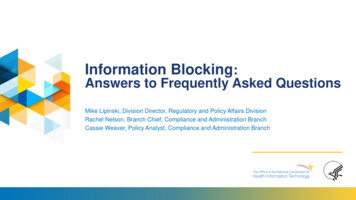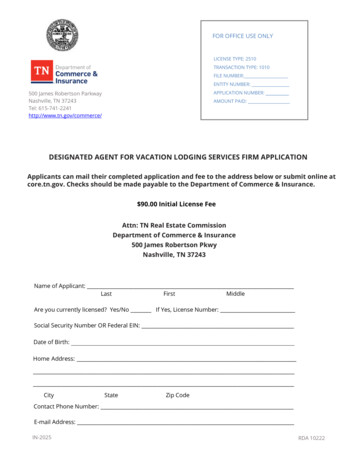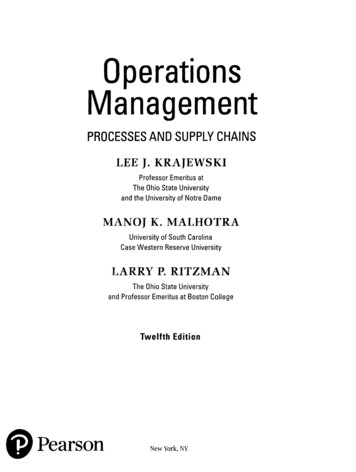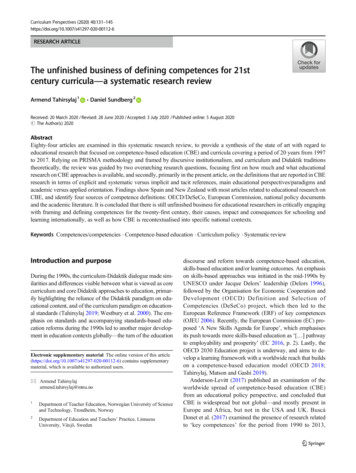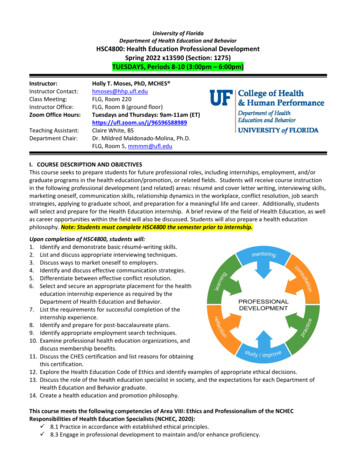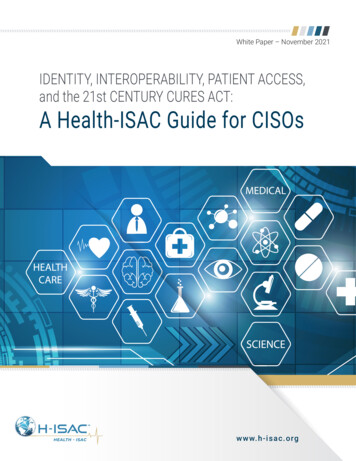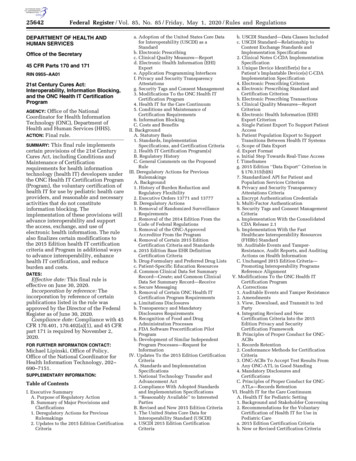
Transcription
Defining EHI andthe Designated Record Setin an Electronic World
EHI Task Force ReportIntroductionIn 2016, Congress passed and enacted into law the 21st Century Cures (Cures) Act, a farreaching, bipartisan bill intended to accelerate medical product development and bring newinnovations and advances more quickly and efficiently to patients that need them. Key provisionsof Cures sought to enhance health information interoperability and prohibit information blockingby “actors,” including healthcare providers, health information networks, health informationexchanges, and health IT developers. The Office of the National Coordinator for Health IT (ONC)Cures Act Final Rule, which was released in March 2020 and published in the Federal Register onMay 1, 2020, implements the interoperability requirements laid out in Cures.ONC Cures Act Final RuleA key provision of Cures prohibits actors from “interfer[ing] with, prevent[ing], or materiallydiscourag[ing] the access, exchange, or use of electronic health information.”1 The ONC CuresAct Final Rule defines electronic health information, or EHI, as:electronic protected health information (ePHI) as the term is defined for HIPAA in45 CFR 160.103 to the extent that ePHI would be included in a designated recordset as defined in 45 CFR 164.501, regardless of whether the group of records areused or maintained by or for a covered entity as defined in 45 CFR 160.103 butEHI shall not include (1) psychotherapy notes as defined in 45 CFR 164.501; or (2)information compiled in reasonable anticipation of, or for use in, a civil, criminal, oradministrative action or proceeding.2Another important provision of Cures requires certified health IT developers, as part of the new2015 Cures Edition certification criterion, to provide a means to export all EHI that a certifiedhealth IT system can store at the time of certification for: (1) a single patient and (2) all patientswhose EHI is in the system. ONC indicated that uses of this export feature might include a patientrequesting their own information or a healthcare provider choosing to migrate information toanother health IT system. The EHI export certification criterion relies on the same definition ofEHI as above.Beginning October 6, 2022, actors will be expected to adhere to the fullscope of EHI for purposes of information blocking compliance.Certification to the EHI export criterion is expected byDecember 31, 2023.21PL 114-255.245 CFR 171.102.
EHI Task Force ReportDesignated Record Set under HIPAAUnderstanding the definition and scope of EHI requires deep familiarity with the DesignatedRecord Set (DRS) as defined under the HIPAA Privacy Rule, which established the concept ofthe DRS as the foundation of a patient’s “right of access” to protected health information (PHI).It further defined the DRS as a group of records maintained by or for a Covered Entity (CE)that is/are:1. medical records and billing records about individuals maintained by or for a coveredhealthcare provider;2. enrollment, payment, claims adjudication, and case or medical management recordsystems maintained by or for a health plan, or3. used, in whole or in part, by or for the covered entity to make decisions about individuals.The term “record” means any item, collection, or grouping of information that includesprotected health information and is maintained, collected, used, or disseminated by or fora covered entity.3Using the definition above, covered entities today generally interpret for themselves whichrecords may be included in the DRS for compliance purposes. As a result, and as depictedin the diagram below through the red arrows, there is variation and discrepancy in howhealthcare organizations decide which types of records are included in their DRS. In turn, thishas led to longstanding inconsistencies and confusion for CEs and Business Associates (BAs)over how to comply with federal regulations.Data Universes under HIPAA and Information BlockingDefinition PHI—45 CFR 160.103 DRS—45 CFR 164.501 ePHI—electronic subset of PHI EHI—intersection of ePHI and DRSChallenges DRS to some extent is fluid by implementationthus scope of EHI can change by provider, eventhough it may involve the exact same data set,ePHI, available.3345 CFR 164.501. AHIMA 2021
EHI Task Force ReportScope of WorkUnited in the belief that a consensus-based understanding of the definition of EHI could benefitpatient, providers, and developers, the American Health Information Management Association(AHIMA), the American Medical Informatics Association (AMIA) and the Electronic Health Record(EHR) Association collaborated to examine the relationship between specific aspects of the ONCCures Act Final Rule and the definitions of the DRS and EHI.Over the last year, a Task Force convened by these groups has sought to develop consensusrecommendations among health information professionals, health informaticists, and healthIT professionals on how to standardize expectations for data classes relevant to the DRS andEHI. The consensus recommendations in this report are intended to guide stakeholders on waysto operationalize these regulatory concepts in an electronic environment. Each of the hostorganizations contributed participants to a joint working group to further these goals, and workedwithin their organization to solicit additional input and contributions. The Task Force also soughtfeedback from provider organizations and other stakeholders.This report describes the process the Task Force used to evaluate the definition of EHI and itsrelationship to the DRS, and outlines key considerations that stakeholders should take intoaccount when operationalizing these concepts. The report also includes the Task Force’s reviewof data classes commonly maintained in health IT and the DRS against the definition of EHI, ananalysis that helped frame development of the key considerations and recommendations. TaskForce members agreed that whether a particular data class is considered EHI will evolve overtime. For that reason, we consider the data classes reviewed by the Task Force as an exemplary“floor” for what might qualify as EHI. Actors will therefore need to keep in mind that should apatient, caregiver or third-party ask for information that is not a data class examined in thisreport, it does not mean that the information requested is not necessarily part of the DRS or EHI.Following is the process the Task Force used to examine the definition of EHI and its relationship tothe DRS. As part of this process, the Task Force identified a number of key issues in relation to thedefinition of EHI.ProcessThe Task Force began its work by examining data classes that are commonly contained in healthIT and exchanged today to determine whether such data classes were also EHI. The Task Forcethen evaluated data elements that might be exchanged less frequently. These data classes wereidentified from:1. ONC’s US Core Data for Interoperability (USCDI) and ONC New Data Element and Class(ONDEC) website4;2. Health IT developer lists of data classes maintained in their products; and3. Best practices previously developed by AHIMA5.Rather than develop new definitions for each examined data class, the Task Force applied existingUSCDI and ONDEC definitions for consistency. For data classes that did not have a relatedUSCDI or ONDEC definition, the Task Force provided examples of the respective data classes.The date classes reviewed by the Task Force can be found in Table 1.445Available at: https://www.healthit.gov/isa/ONDEC.Available at: https://library.ahima.org/doc?oid 104008#.YS5ZG45Kg2w. AHIMA 2021
EHI Task Force ReportTable 1: Data Classes Reviewed by Task ForceDATA CLASSDEFINITION OF DATA CLASSUSCDI v1 Data ClassesAllergies(See USCDI definitions.)Assessment and plan of treatment(See USCDI definitions.)Care team members(See USCDI definitions.)Clinical notes(See USCDI definitions.)Goals(See USCDI definitions.)Health concerns(See USCDI definitions.)Immunizations(See USCDI definitions.)Lab tests and results(See USCDI definitions.)Demographics(See USCDI definitions.)Problems(See USCDI definitions.)Procedures(See USCDI definitions.)Provenance(See USCDI definitions.)Smoking status(See USCDI definitions.)Implanted device identifiers(See USCDI definitions.)Vitals(See USCDI definitions.)USCDI v2 Data ClassesEncounters(See USCDI definitions.)Diagnostic imaging(See USCDI definitions.)ONC ONDEC Data Classes5Facility data(See ONDEC definitions.)Family health history(See ONDEC definitions.)Health insurance(See ONDEC definitions.)Orders(See ONDEC definitions.)Observations(See ONDEC definitions.)Medical devices or equipment(See ONDEC definitions.)Social determinants of health(See ONDEC definitions.)Social history(See ONDEC definitions.)Specimen(See ONDEC definitions.)Travel information(See ONDEC definitions.)Advance directives(See ONDEC definitions.)Biologically derived product(See ONDEC definitions.)Ophthalmic data(See ONDEC definitions.)Security label(See ONDEC definitions.)Substance use(See ONDEC definitions.)Work information(See ONDEC definitions.)Functional assessments(See ONDEC definitions.) AHIMA 2021
EHI Task Force ReportOrganization data(See ONDEC definitions.)Referrals(See ONDEC definitions.)Research data(See ONDEC definitions.) Example data elements:study name, status.Additional Data Classes DiscussedProvider-provider messages with patient-identifiable informationExample: secure emails linked to a patient.Provider-provider chat messages with patient-identifiableinformationExample: secure chat messages linked to a patient.Patient-provider messagesExample: secure emails linked to a patient.Audit trailExample: §170.315(d)(2) in the 2015 Edition certification criteria.Clinical decision support historyExample: records that a particular drug interaction appearedto a clinician and the clinician’s responseto the interaction.Event logsExample: provider login times, logout times, system logouts.Credentialing recordsQuality reportsConsents (TPO, negotiated, HIE, medication consents)Census informationPatient transportationExample: moving a patient from one room of thehospital to another.Events (admission, discharge, transfer)Prior authorizations or authorizationsClaimsBilling codes assignedExample: when coding a hospital account.Hospital account and coverageA/R transactionsPrice estimates given to patientLists of prices/chargesFinancial assistance applicationsFinancial assistance decisionsEligibility informationCharges, refunds, deductibles, interest paid/duePaymentsDenialsBilling statements and summariesCollection informationPregnancy history, maternity, pregnancy status6Patient relationshipsExample: non-clinical participants in a care team, socialsupport structures, family support structures.Patient educationDocumentation of education provided to the patient. AHIMA 2021
EHI Task Force ReportKey Considerations: Status ConditionsThe Task Force identified several key considerations to take into account when interpreting and applyingthe definition of EHI. Task Force members first identified that in some circumstances certain data classesmay not be considered EHI depending on their “status.” For example, some data classes may have a statuscondition such that it is not used in decision-making and therefore would not be considered EHI. Furtherdiscussion on how to differentiate those types of data classes will be important. Task Force membersagreed that there is an inherent challenge in that use of a particular data class in decision-making is a keyfactor in the definition of EHI but not necessarily easy to track programmatically in an HIT system, leadingto actors either casting a wide net as to what is considered EHI or relying on manual identification.The Task Force identified several status conditions including:1. Unvalidated data2. Draft data3. Duplicative data4. Data that does not meet the ePHI definitionThe first three conditions reflect discussion of a specific instance of that data class’s inclusion within theDRS set definition. Examples of each of these status conditions can be found below.Status ConditionsUnvalidated DataExamples of unvalidated data may include external records prior to clinical review or reconciliation, ordevice readings that have not been reviewed or checked by a clinician. Patient-generated data that issubmitted to a clinician prior to clinical review or reconciliation may be another example of unvalidateddata, as is data used for teaching workflows if a medical student writes materials that are later validated.Additional exploration is needed to define what “validation” means and when validation processes mayoccur. Whether validation is needed may depend on certain contexts. For example, data from consumerapplications may require different validation workflows as compared to clinical applications. In contrast, areport from a clinician that does not work at the healthcare facility that is filed in the patient’s record butnever validated would likely be considered EHI because it is the type of information that would be reliedupon for decision-making and therefore part of the DRS.Further work is also needed to examine how such validation processes may occur and who is responsiblefor such validation. The Task Force recognized that validation may be performed by clinical oradministrative staff depending on the type of data class involved. Task Force members also agreed thathaving processes for validation should not be used as an excuse to not share data.Draft DataSimilar to unvalidated data, draft data may include a clinical note in progress, for example that may bewritten or edited but not yet signed. Draft data may also include reports that are in the process of beingwritten or edited that have not been signed by the clinician. Pre-charting was also identified as draft datathat therefore may not be considered EHI. Another example is data used for teaching workflows, provideda medical student begins the work and it is later taken over by other authors.7 AHIMA 2021
EHI Task Force ReportDuplicative DataThere was consensus within the Task Force that if information is maintained in duplicate formatsor systems, the holder may have the flexibility to choose from which system the EHI could beproduced. For example, audio transcription files and transcribed text or lab result informationmay be in both a lab system and an electronic health record (EHR) and used for decision-making.In such circumstances, the holder should be able to determine which system they would pull theEHI from when it is requested.Data Does Not Meet the ePHI DefinitionONC defines EHI as ePHI to the extent that ePHI would be included in a DRS, regardless of whetherthe group of records is used or maintained by or for a covered entity. Task Force members agreed thatthis seems to broaden the applicability of the definition of EHI 45 CFR 171.102. However, the definitionsof ePHI and Individually Identifiable Health Information (IIHI), which helps to set the scope of ePHI,indicate that the context of collection and HIPAA definitions still play a role in defining EHI as well.Therefore, the Task Force believes that information must be collected by a CE or BA of the CE whenthey are acting as CEs or BAs and not as employers or in other capacities. This additional contextensures that travel information collected by a non-CE/BA, such as a travel agency or informationcollected by a CE/BA acting as an employer, when the data would not be part a medical or billingrecord, does not qualify as EHI. However, that same travel information collected by a CE/BA as partof a medical/billing record or potentially used to make a decision about a patient would be EHI.Similarly, data classes that are not patient identifiable such as information that lacks the 18 typesof individual identifiers under the Safe Harbor standard of the HIPAA Privacy Rule or data that hasbeen de-identified by expert determination consistent requirements of 45 CFR 164.514(b)(1) arenot considered EHI. In both of these instances, because the data is not considered ePHI, it wouldnot meet the threshold to constitute EHI. This analysis appears consistent with the preamble ofthe Final Rule in which ONC states:We agree that health information that is de-identified consistent with therequirements of 45 CFR 164.514(b) should not be included in EHI. It is not, however,necessary to specifically exclude such de-identified information from the EHIdefinition because information that does not identify an individual, and with respectto which there is no reasonable basis to believe the information can be used toidentify an individual, is not individually identifiable information, so it would not beEHI. To note, once PHI has been de-identified, it is no longer considered to be PHI.6Additional considerationsThe Task Force also discussed whether more granular distinctions might be useful to consider inthe future when defining EHI. For example, input from provider groups suggested the age of thedata might be an important factor in considering the value of exchanging it, even though dataage is not considered in the definition of EHI or in the context of information blocking.The Task Force also identified some data classes that were clearly EHI, but that might meritspecial policy considerations, including: Balancing the privacy of care team members when disclosing their names as partof the “care team” data class under USCDI version 2. Recognizing the diversity of types of information contained in some data classes,such as noted in USCDI v1, and the difficulty of managing sensitive informationwithin the note such as behavioral health information.68 21st Century Cures Act: Interoperability, Information Blocking, and the ONCHealth IT Certification Program, 85 Fed. Reg. 25,804 (May 1, 2020). AHIMA 2021
EHI Task Force ReportUpon identifying the aforementioned status conditions, the Task Force proceeded to assess the dataclasses identified in Table 1 to determine whether certain status conditions may apply to the dataclasses, in which case the data class may not be considered EHI. The Task Force’s analysis can befound in Table2.Table 2: Application of Status Conditions to Data ClassesDATA CLASSDEFINITION OFDATA CLASSIS IT EHI? STATUS CONDITIONSADDITIONALCONSIDERATIONSUSCDI V1 DATA CLASSESAllergies(See USCDI definitions.)YesUnvalidated, draft, duplicated.Assessment and plan oftreatment(See USCDI definitions.)YesUnvalidated, draft, duplicated.Care team members(See USCDI definitions.)YesUnvalidated, duplicated.Clinical notes(See USCDI definitions.)YesUnvalidated, draft, duplicated.Goals(See USCDI definitions.)YesUnvalidated, draft, duplicated.Health concerns(See USCDI definitions.)YesUnvalidated, draft, duplicated.Immunizations(See USCDI definitions.)YesUnvalidated, draft, duplicated.Lab tests and results(See USCDI definitions.)YesUnvalidated, draft, duplicated.Demographics(See USCDI definitions.)YesUnvalidated, draft, duplicated.Problems(See USCDI definitions.)YesUnvalidated, draft, duplicated.Procedures(See USCDI definitions.)YesUnvalidated, draft, duplicated.EHI only when linked to anidentified patient as arelationship.Provenance is a metadataclass, which makes it uniquein USCDI v1. The Task Forcedid not venture fully into thediscussion given definitionally, USCDI v1 is currentlyconsidered EHI. However, theTask Force acknowledgedthat, like other metadata, itmay not be EHI (as metadata, it is not necessarily healthinformation).9Regardless, in many casesthe Task Force agreed itmakes sense to share thismetadata along with data inUSCDI for context.Provenance(See USCDI definitions.)UncertainSmoking status(See USCDI definitions.)YesUnvalidated, draft, duplicated.Implanted device identifiers(See USCDI definitions.)YesUnvalidated, draft, duplicated.Vitals(See USCDI definitions.)YesUnvalidated, draft, duplicated. AHIMA 2021
EHI Task Force ReportUSCDI V2 DATA CLASSESEncountersDiagnostic imaging(See USCDI definitions.)(See USCDI definitions.)Encounters includes pastencounters as well asscheduled appointments.YesUnvalidated, duplicated.YesThis data class mightencompass both the imageand the report. Some of theconditions (for example,draft status) would not beapplicable to an imagebut would be applicable toUnvalidated, draft, duplicated. the report.ONC ONDEC DATA CLASSESFacility data(See ONDEC definitions.)UncertainUnvalidated, duplicated.Family health history(See ONDEC definitions.)YesUnvalidated, draft, duplicated.Health insurance(See ONDEC definitions.)YesUnvalidated, duplicated.Orders(See ONDEC definitions.)YesUnvalidated, draft, duplicated.Observations(See ONDEC definitions.)YesUnvalidated, draft, duplicated.Medical devices orequipmentUncertainUnvalidated, duplicated.Medical devices may beEHI only when linked to anidentified patient due tousage, implantation, etc.Social determinants ofhealth (SDOH)(See ONDEC definitions.)YesSDOH is considered EHI ifdocumented in the course ofcare or if accepted, receivedUnvalidated, draft, duplicated, or stored by an actor andnot ePHI.used for decision making.Social history(See ONDEC definitions.)YesUnvalidated, draft, duplicated.Specimen(See ONDEC definitions.)YesUnvalidated, draft, duplicated.Travel information(See ONDEC definitions.)YesUnvalidated, duplicated, notePHI.Advance directives(See ONDEC definitions.)YesSimilar concepts includeliving will, medical powerof attorney, etc. shouldbe evaluated similar toUnvalidated, draft, duplicated. advanced directives.Biologically derived product(See ONDEC definitions.)YesUnvalidated, duplicated.Ophthalmic data(See ONDEC definitions.)YesUnvalidated, draft, duplicated.Security label10(See ONDEC definitions.)Facility data may be EHI onlywhen linked to an identifiedpatient as a relationship.(See ONDEC definitions.)UncertainThe Task Force recognizedthe value of this for interoperability, as well as interest inthis for legal reasons, or for apatient validating that labelsthey desired were accuratelyapplied. However, there isskepticism that it is healthinformation. AHIMA 2021
EHI Task Force ReportSubstance use(See ONDEC definitions.)YesUnvalidated, duplicated.Work information(See ONDEC definitions.)YesUnvalidated, duplicated,not ePHI.Functional assessments(See ONDEC definitions.)YesUnvalidated, draft, duplicated.Organization data mightbe EHI only when linked toan identified patient as arelationship.Organization data(See ONDEC definitions.)UncertainUnvalidated, duplicated.Referrals(See ONDEC definitions.)YesUnvalidated, draft, duplicated.Research data(See ONDEC definitions.)Example data elements:study name, status.YesUnvalidated, duplicated,not ePHI.YesTask Force discussedUnvalidated, draft, duplicated, difficulties with sharingnot ePHI.this data class.Provider-provider chat mes- For example, secure chatsages with patient-identifimessages linked to aable info†patient.YesTask Force discussedUnvalidated, draft, duplicated, difficulties with sharingnot ePHI.this data class.For example, secureemails linked to a patient.YesUnvalidated, draft, duplicated,not ePHI.There may be sensitiveinformation implied evenin a study name.ADDITIONAL DATA CLASSES DISCUSSEDProvider-provider messageswith patient-identifiableinfo†Patient-provider messages†NoIt captures informationabout electronic healthinformation, but is not healthinformation.Clinical decision supporthistoryFor example, recordsthat a particular druginteraction appearedto a clinician and theclinicians response to theinteraction.UncertainConceptually this is anothertype of audit trail, but theproximity to decision makingprompted discussion.Event logsFor example, providerlogin times, logout times,system logouts.NoNot ePHI.Audit trailFor example, (d)(2) incertification.Credentialing recordsNoQuality reportsNoConsents (TPO, negotiated,HIE, medication consents)YesCensus informationNoNot ePHIFor example, moving fromone room of the hospitalto another.NoNot ePHI.Patient transportationUnvalidated, draft, duplicated.Events (admission,discharge, transfer)YesUnvalidated, duplicated.Prior auth or authorizationsYesUnvalidated, draft, duplicated.ClaimsYesUnvalidated, draft, duplicated.For example, when codinga hospital account.YesUnvalidated, draft, duplicated.Billing codes assigned11For example, secureemails linked to a patient. AHIMA 2021
EHI Task Force ReportHospital account andcoverageYesA/R transactionsNoPrice estimates givento patientYesLists of prices/chargesNoFinancial assistanceapplicationsYesUnvalidated, draft, duplicated.Financial assistancedecisionsYesUnvalidated, duplicated.Eligibility informationYesUnvalidated, duplicated.Charges, refunds, deductibles, interest paid/dueYesUnvalidated, duplicated.PaymentsYesUnvalidated, duplicated.DenialsYesUnvalidated, duplicated.Billing statements andsummariesYesUnvalidated, draft, duplicated.Collection informationYesUnvalidated, duplicated.Pregnancy history,maternity, pregnancy statusYesUnvalidated, duplicated.Patient relationshipsFor example, non-clinicalparticipants in a careteam, social supportstructures, family supportstructures.YesUnvalidated, duplicated, notePHI.Patient educationDocumentation ofeducation provided to thepatient.YesUnvalidated, draft, duplicated.Unvalidated, draft, duplicated.Unvalidated, draft, duplicated.Not patient identifiable.† Various types of provider communications (provider-provider messages, provider-provider chats, patient-providermessages, etc.) were discussed by the Task Force. In general, there were concerns that the wide variety of content thatmight be encompassed in a message makes it difficult to assess generically whether the content within is EHI or not. Therewas consensus among Task Force members that communications without individually identifiable patient information arenot considered EHI. The Task Force also discussed an expectation that content within communications be incorporatedinto another data class (such as a note) if used in decision-making and under such circumstances would be considered EHI.If this were done consistently, that would offer confidence that provider communications did not include non-duplicative EHI.However, there was not confidence that this is widely adopted in practice today. Rather, there were concerns about the workflowburden of adopting such a practice and concerns about the downstream workflow impact of greater incorporation of data intonotes, which can already suffer from “note bloat.”12 AHIMA 2021
EHI Task Force ReportConclusionOur analysis demonstrates the complexity associated with defining EHI for multipurpose use,such as in ONC’s certification program and compliance with information blocking. Whethera data class is considered EHI may depend on certain status conditions or characteristics.Other data classes might merit special consideration, such as behavioral health information.Throughout this process, Task Force members have agreed that what data classes areconsidered EHI will continue to evolve over time. However, we firmly believe that standardizingclinician and developer expectations around the definition of EHI will be critically important tosuccessful operationalization of the Cures Act Final Rule.The Task Force intends to continue its work following the release of this report. This will includeseeking feedback from stakeholders regarding key findings of this report, further discussionswith stakeholders to refine a consensus understanding of what data classes are consideredEHI, including follow-up actions by the federal government and/or private sector to furtheroperationalize the definition of EHI. This includes further exploration of whether commoncharacteristics across covered entities could yield a common interpretation of the designatedrecord set that can serve as a template to improve consistency. For that reason, the TaskForce does not consider these findings to be “final.” Rather, we welcome input and feedbackfrom stakeholders as we intend to evolve these findings to adapt to technical, regulatory, andbusiness considerations.AHIMA, AMIA and the EHR Association look forward to working with other stakeholders in thehealthcare community in seeking to advance a common understanding of the definition of EHIand iterate on the findings in this report.13 2021 AHIMA. All rights reserved. Reproduction and distribution ofthe EHI Task Force Report without written permission of AHIMA is prohibited.298.21 AHIMA 2021
Cures Act Final Rule, which was released in March 2020 and published in the Federal Register on May 1, 2020, implements the interoperability requirements laid out in Cures. . (EHR) Association collaborated to examine the relationship between specific aspects of the ONC Cures Act Final Rule and the definitions of the DRS and EHI.
